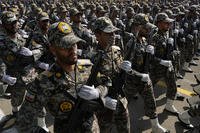The Taliban fighters who shot down the CH-47 Chinook and killed 38 people on Saturday were killed by an American airstrike on Monday, said the top U.S. commander in Afghanistan. Marine Gen. John Allen told reporters at the Pentagon Wednesday via satellite that U.S. commanders tracked the group of insurgents that fired the rocket propelled grenade at the helo, apparently back to a hideout, and then ordered an Air Force F-16 to put "ordnance on target." Which it did.
Allen said he and other top leaders were confident it was the same group of men, but he did not go into details about how they were tracked or how that was confirmed. This is just Buzz talking, but it's possible a Predator or other unmanned surveillance aircraft was watching Saturday's operation as a matter of course, and it may have caught the insurgents firing on the helo and followed them fleeing the area.
Allen confirmed everyone's basic understanding of what happened: American special operators were pursing a senior Taliban commander who runs the local insurgent network in that part of Wardak Province. After they got intel he might be in a position to be captured or killed, Army Rangers apparently went in to try to take care of it. The Taliban leader and his entourage offered resistance, which led to a firefight, and they also apparently began to slip away. So the Rangers called for help from the SEAL Development Group operators, who were on their way in aboard the Chinook when another group of Taliban insurgents shot it down.
Allen also confirmed that he believes at least one RPG hit the Chinook, but he said he couldn't rule out that it might have taken small arms fire, too -- those details will come out as a part of the investigations. Reporters pressed him for explanations about some of the big questions about this operation: Was it smart to put so many high-value special operators on one big helo? Was it smart to send them into the fight aboard a regular Army Chinook? What are you going to change about the way you operate in the wake of these losses?
Allen said he would not talk about details of special operations and reiterated the DoD line that the investigation into this crash -- which will be headed by Army Brig. Gen. Jeffrey Colt, the deputy commanding general of the 101st Airborne Division -- will determine all the facts and yield the appropriate "lessons learned."
The Taliban leader who was the object of the whole operation ended up escaping, Allen acknowledged, but he said the special operations teams will not let up on the pressure they've been putting on him and his network. He said Saturday's operation was just one of many going on across Afghanistan, and that all the different flavors of SOF across the country will continue at their high levels of operational tempo.
Neither Allen nor reporters addressed a key question: Was this whole thing a setup? Was this "Taliban leader" just bait? Allen repeated his and other top officials' belief that Saturday's crash, however terrible, does not reverse ISAF's progress in the war. Allen reiterated top officials' line about how, because the Taliban is so weak, it has had to change its tactics and focus on "spectacular attacks," including assassinations and suicide bombings of civilian targets, because it's no longer capable of stand-up fights with American and allied troops. (To the extent it ever truly was.) But even though DoD officials say 'we need to wait until the facts are in' before concluding that Saturday's crash might have been a Taliban trap, as Afghan officials claim, they have implicitly acknowledged it's a possibility: If insurgents really are changing their tactics to try to inflict maximum casualties with a smaller, weaker force, this would seem to be a textbook example.
Then again, it's also possible that elements within the Afghan government just made that up, to try to make what could have been a lucky break, from the Taliban's perspective, seem as though it had been planned all along. And if the Taliban does reel out more of its fighters and leaders to try to spring these kinds of traps, American commanders might well agree to play the game despite the risks, betting that their superiority across the board will give them the edge no matter what the bad guys think they can make happen.








